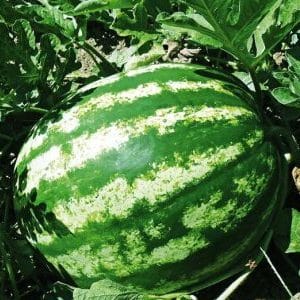Is it worth buying “Producer” watermelon seeds: a review of the variety by American breeders, its advantages and disadvantages
American watermelon The producer is famous for his appearance and taste. Watermelon is sweet and is grown for personal use and for sale. The producer is resistant to diseases and pests; regions with a temperate climate and fertile soil are chosen for cultivation.
In this article we will consider in detail the description of the Producer variety and learn the secrets of its cultivation.
Description of the watermelon variety
The Producer variety is grown both in greenhouse conditions and in the open air. The variety is early ripening, the harvest is harvested 55-65 days after the appearance of the first shoots.
Distinctive features
The bushes of the variety are powerful and medium in size. The leaf is dark green and large. The Producer is capricious when growing and requires increased attention. Productivity directly depends on the irrigation regime and fertilizing.

Composition, properties, benefits, calorie content
Watermelon is classified as a dietary product. 100 g contains only 25 kcal. It has a choleretic effect and is good for the kidneys. The pulp contains macro- and microelements: calcium, magnesium, phosphorus, iron. They improve human immunity and help lose extra pounds.
Watermelon eliminates inflammatory processes in the stomach, cleanses blood vessels and removes from the body cholesterol. The fiber in the product has a delicate laxative effect and normalizes intestinal function.
Fruit characteristics and yield
The shape of the fruit is oval, the bark is thin, striped. Color dark or light green.The weight of watermelon varies from 8 to 14 kg.
The pulp is juicy and sugary. About 12 kg are collected from 1 m² ripe harvest.
Seeds
The seeds are small and black. The seeds contain pectin - it removes heavy metals and pesticides from the body.
Interesting! Dry seeds consist of 35% protein, they are useful for muscle growth and saturate the body with energy. It is recommended to fry the seeds in a saline solution before eating. This makes them more tasty and crispy. The seeds are cooled before serving.
How to grow this variety yourself
The Producer variety is planted with seeds in open ground or using seedlings. The second method is more practical - it protects young plants from diseases and unfavorable climates.
Preparing and growing seedlings

Preparation begins with seed disinfection. They are disinfected using a solution of potassium permanganate, the drug "Epin", aloe juice or Bordeaux mixture. The seeds are placed in a cloth and dipped in liquid for 10-15 minutes. Then they are dried and germinated, wrapped in a damp cloth for several days.
Wooden boxes with plastic trays are suitable for seedlings. They are filled with earth and grooves are made at a distance of 7-10 cm from each other. Place 1-2 seeds in each hole and sprinkle soil on top. The seedlings are watered generously with warm water and placed in a sunny and bright place.
Important! The soil used is soil from a garden plot or a purchased ready-made compound. The second option is preferable, since the land is disinfected in advance and enriched with nutrients for plant development. The soils “Universal” and “Krepysh” are popular among gardeners.
Care consists of timely watering and fertilizing.Warm water is used for hydration; cold water provokes the development of diseases. Water the seedlings once every 5-7 days, as the soil dries.
Urea, chicken manure, compost, and superphosphate are used for fertilizer. The first fertilizing is applied 2 weeks after planting, the second - after another 15 days.
Planting in the garden and step-by-step care
The producer loves loose sandy and loamy soils. The beds should be spacious, as the variety has a powerful root system. The best place for planting is light soil away from groundwater. They first dig it up, remove debris and weeds, leaves and remains of last year’s plants. It is recommended to plant watermelon after potatoes, cabbage, and peppers. It is not recommended to use beds after pumpkin or melon.
Important! The Producer variety is planted after the last frost, around the beginning - mid-May. The planting pattern in open ground is 1.5 x 1. Thickened planting leads to the development of viruses and fungal infections. In the first week, the seedlings are covered with thin glass or plastic film to protect them from sudden changes in weather.
Before the ovaries form, the plant is watered in the morning and evening, during the flowering period - 2-3 times a week. A drip irrigation system is suitable for this variety - it is convenient and uses water sparingly. 1 bush requires about 1.5 liters of water.
In addition to hydration, watermelon needs nutritional supplements. Gardeners use organic and mineral substances - ash, potassium salt, yeast, herbal infusion, whey. During the ripening period, 2-3 additional feedings are applied with an interval of 10-15 days.
Features of cultivation and possible difficulties

The main difficulty in growing the Producer variety is the formation of the bush. In open ground, a watermelon is formed into 3 stems, the top is pinched.This is necessary for the healthy development of large fruits.
In the greenhouse, the plant is formed into 1 stem, the rest are tied to a support so that the shoots do not break under the weight. Despite the fact that watermelon is a heat-loving crop, in prolonged hot weather the fruits are covered with burdock leaves.
An important stage in growing crops is regular weeding of the beds., which includes loosening and removing weeds. Weeding makes the soil light and nutritious and maintains healthy microflora in the beds. Weeds are removed to protect against insect pests. We weed watermelon beds once a week before watering.
Diseases and pests characteristic of the variety
Diseases arise due to improper care, sudden changes in weather, and non-compliance with crop rotation rules.
Gardeners highlight:
- Root rot which occurs due to high humidity and excess mineral fertilizers. The root becomes denser, the leaves dry out and turn yellow. The base of the stem is covered with a white coating. For treatment, spraying with Bordeaux mixture or copper sulfate solution is used. For preventive purposes, bushes are sprayed with iodine solution.
- Downy mildew. Appears at any stage of maturation. A fungal disease affects the leaves - they become covered with a white-yellow pattern, become thin and weak. The cause of infection is plant debris and weeds. Downy mildew is treated with HOM and Maxim.
- copperheadcaused by contaminated soil or seeds. The leaves become covered with brown spots and ulcers, and the plant stops growing. The fruits are deformed and covered with a dark pattern. The copperhead is treated with the drugs “Acrobat” and “Maxim”.
One of the pests found on watermelon beds is the melon aphid.The small midge lives on leaves, sucks plant juice and disrupts metabolism. A soap solution or spraying with ash and whey helps to get rid of melon aphids. The procedure is carried out for preventive and therapeutic purposes.
Harvesting and application

The ripeness of a watermelon is determined by its glossy and elastic rind and dry stalk. When tapped, a dull sound is heard - a sign of ripeness of the fruit. Harvest from late August to mid-September. Due to the thin peel, the fruits are not suitable for long-term storage; it is recommended to eat them fresh or process them immediately after harvesting.
Traditionally prepared from sugary pulp jams, jam, sorbets, cocktails. Watermelon is suitable for stewing, pickling, frying and boiling. It is used to prepare a fresh salad with feta cheese, combine it in a radish and herb appetizer, and use it to make cucumber tartare. Sweet jam is made from watermelon rinds, and the seeds are used as infusion for healthy tea.
Advantages and disadvantages of the variety
The disadvantage of the Producer variety is its demanding care. To obtain a rich harvest, watermelon requires timely feeding and watering. Producer is grown only in the south or in the middle zone; it is not suitable for the northern regions.
However, the variety has many advantages:
- sweet taste and dense pulp;
- resistance to diseases and pests;
- useful composition;
- commercial qualities.
Reviews
Let's read several reviews and find out what Russian gardeners say about the American variety Producer.
Valentina, Sochi: “I have known Producer watermelon for a long time; I have been growing it for three years now. I like the fruits; they grow large and heavy. The taste is sweet, there are few seeds. We eat it with the whole family and make jam from watermelon rinds.I recommend it for cultivation."
Maxim, Penza: “I planted the Producer variety last year. I planted seedlings, watered them with infusions of herbs and water. The fertilizers used were mainly manure and ash. I was pleased with the harvest; the largest watermelon weighed 14 kg. The taste is sugary and delicate.”
Maria, Volgograd: “I didn’t like Watermelon Producer. The pulp is too watery, there is not enough sweetness in it. During the growing process, I encountered melon aphids, so I won’t grow this variety anymore.”
Conclusion
Summer residents appreciate the Producer watermelon for its high yield and large fruits. They are planted in warm regions on pre-prepared beds - the ground is dug up and cleared of debris and weeds. The harvest ripens in late summer - early autumn.
Glossy striped fruits are used fresh for preparing fruit snacks and original salads. The pulp of the Producer watermelon is sugary and sweet, the peel is thin, and there are few seeds.